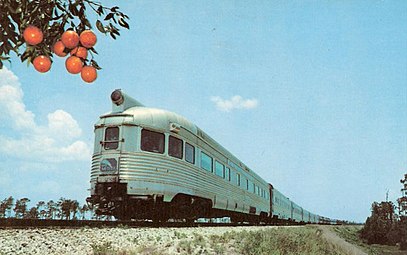Lounge car
A lounge car (sometimes referred to as a buffet lounge, buffet car, club car or grill car) is a type of
Lounge cars operated by Pullman were exclusively for the use of sleeping car passengers, while those operated by the railroad were available to coach as well as first-class travelers. Buffet lounge cars were often found in trains which did not offer full dining car service. On other trains they supplemented the diner and offered sandwiches, burgers and short orders at times when the diner was not serving; e.g. mid-afternoon and late night. To qualify as a buffet lounge the car had to offer both food and drink service. Buffet lounges should not be confused with snack or grill cars which did not offer a full range of libations.[2]
In
Gallery
-
Postcard of aSeaboard Air Line Sun Loungeinterior in the 1960s.
-
Interior of an Amtrak Superliner Sightseer lounge car. These were based on the Seaboard’s Sun Lounge and the ATSF’s Hi-Level lounge.
Tavern-lounge cars
Tavern-lounge cars, alternatively called tavern-observation cars, were lounge cars often with partitions, where refreshments were offered for sale. They came in either round-end or flat-end configurations. In use from the post-World War II years, into the 1970s, these appeared on long-distance routes, such as the
-
Shasta Daylight Timberline Tavern lounge car
-
Postcard depiction, circa 1948, of the tavern-observation car. A radio allowed broadcasts and music to be heard throughout the train.
-
Publicity photo of the Silver Meteor’s round-end tavern-lounge-observation still bringing up the rear in the 1960s.
See also
References
- ISBN 978-0-8018-2743-3.
- ^ "Definition of CLUB CAR".
- ^ "Railfan.net Forums - "Buffet Lounges"".
- ^ American Rails, Vacationer, https://www.american-rails.com/vacationer.html
- ^ 1961 Atlantic Coast Line Timetable, p. 9
- ^ 1947Louisville & Nashville Timetable http://viewoftheblue.com/photography/timetables/L&N82447.pdf
- ^ 1948 New York Central Timetable, p. 6 http://streamlinermemories.info/NYC/NYC48-4TT.pdf
External links
 Media related to Saloon coaches at Wikimedia Commons
Media related to Saloon coaches at Wikimedia Commons- Amtrak Lounge Cars





